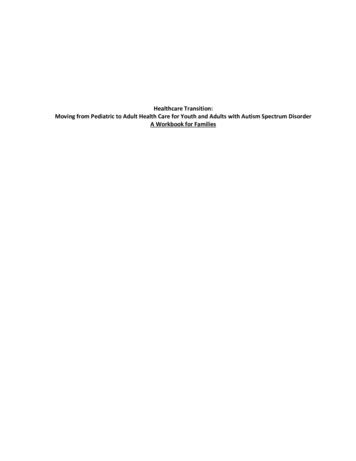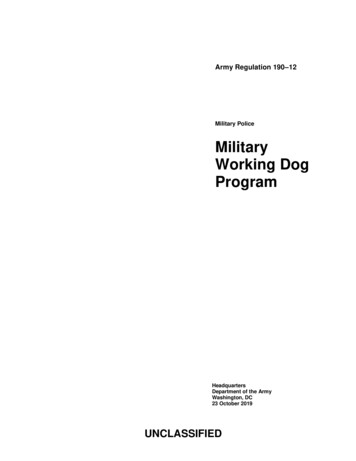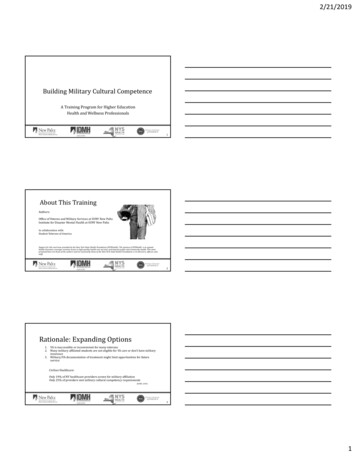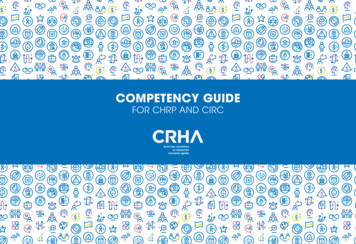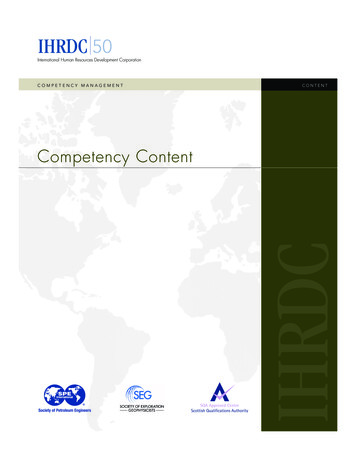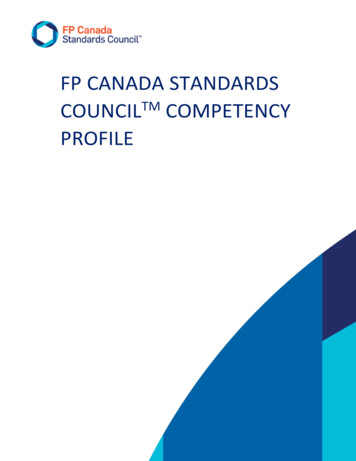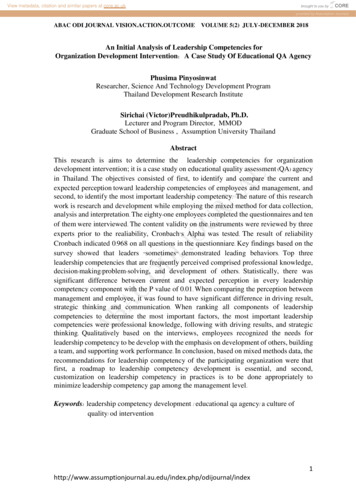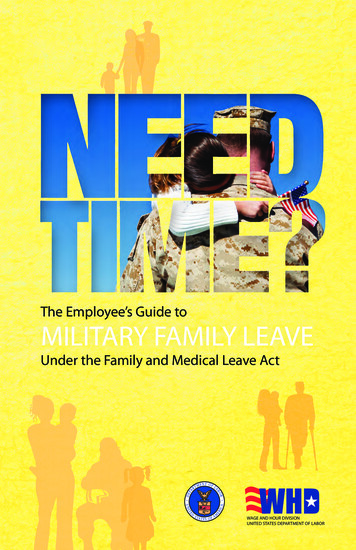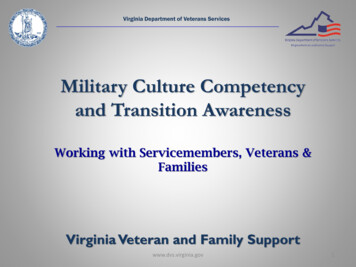
Transcription
Virginia Department of Veterans ServicesMilitary Culture Competencyand Transition AwarenessWorking with Servicemembers, Veterans &FamiliesVirginia Veteran and Family Supportwww.dvs.virginia.gov1
Virginia Department of Veterans ServicesIntroductionsWhy Is This Important?How many of you served in the U.S. Military?How many of you are immediate family members of someonewho is or did serve in the U.S. Military?How many of you have worked with a Servicemember, Veteranor family member in the last 90 days?www.dvs.virginia.gov2
Virginia Department of Veterans ServicesMilitary Culture CompetencyThis training provides an overview of military culture to includeorganizational structure, rank, branches of service, core values,and demographics as well as similarities and differencesbetween the Active and Reserve components, National Guardand Military Family awareness.It also provides awareness of transition and reintegration needsfor veterans and members of the National Guard and ArmedForces Reserves and their Families.www.dvs.virginia.gov3
Virginia Department of Veterans ServicesLearning Objectives Describe the military organizational structure, rank, branches of service, corevalues, and demographics Identify differences between the Active and Reserve components andNational Guard Identify characteristics of military transitions from active duty, deploymentand reintegration to civilian life and the challenges that arise Identify best practices to enhance behavioral health, treatment options andresources for military servicemember veteran family (SMVF) in communitysettings Identify resources for SMVF, caregivers and providers Discuss the prevalence and characteristics of suicide among military servicemembers, and veterans according to Federal and State data sourceswww.dvs.virginia.gov4
Virginia Department of Veterans ServicesMilitary Active Duty Population 1,429,995 active duty members More than half of these are 25 years old or younger Approx. 54% are married Approx. 42% have childrenApprox. 7% are single parents 7% of active duty are dual militarycouples Approximately 3 million troops haveserved in support of OIF/OEF/ONDwww.dvs.virginia.gov5Source: Center for Deployment Psychology
Virginia Department of Veterans ServicesFederal Veteran DefinitionWhat is a Veteran?Title 38 of the Code of Federal Regulations defines aveteran as; “a person who served in the active military, naval, orair service and who was discharged or released under conditionsother than dishonorable.”www.dvs.virginia.gov6
Virginia Department of Veterans ServicesOur Veteran Population 19,998,799 veterans in the U.S.5.1 million are between ages of 25-505.2 million are between ages of 50-659.4% of veterans are women7.2 million Gulf War Veteranswww.dvs.virginia.govSource: National Center for VeteransAnalysis and Statisticswww.va.gov/vetdata7
Virginia Department of Veterans ServicesVirginia VeteransTotalVeteransVirginia has approximately 725,000 veteransPopulationVirginia currently has the 8th largest veteranpopulation in the nation, however by 2023, Virginiais projected to be ranked 5thYoungFemaleVirginia ranks 5th in younger veterans (age 17 – 39)33% of the Virginia veteran population is under theage of 50Virginia has the largest percentage of womenveterans to total veterans, 14% (Nationally, femalesare 9% of the vet pop)Source: National Center for Veterans Analysis and Statisticswww.va.gov/vetdatawww.dvs.virginia.gov8
Virginia Department of Veterans ServicesDemographics in the U.S. MilitaryDeployed around the world, the armed forces are a pillar ofU.S. power and influence abroadHow much does the military resemble U.S. society at large?1973 - The United States ended the draft for military service,transitioning to the all-volunteer force that exists todayAt the time, the active component of the militarycomprised 2.2 million men and women, that’s now under 1.2millionwww.dvs.virginia.gov9
Virginia Department of Veterans ServicesActive Duty Personnel 1974 - 2016www.dvs.virginia.gov10
Virginia Department of Veterans Services6 Facts About Diversity in the Military The Army remains the largest branch of the U.S. military. The active-duty force remains largely male-dominated, but women havemade inroads in recent decades As the country has become more racially and ethnically diverse, so hasthe U.S. military The active-duty military has grown older in the past 40 years. Military officers have considerably higher levels of educationalattainment, on average, than enlisted personnel and U.S. adults There is much more to the U.S. military than the active-duty forcewww.dvs.virginia.gov11
Virginia Department of Veterans Services“The armed forces pride themselves on being leaders indiversity. In addition to providing equality, diversitygives the military more strength by ensuring that itreflects the very same population it’s called to defend.”*Dr. David S. Chu Former Undersecretary of Defense for Personnel andReadinesswww.dvs.virginia.gov12
Virginia Department of Veterans ServicesArmed Forces ReservePerforming duties one weekend per month, plus twoweeks of training per year, members of the Reserves andNational Guard are considered part-timewww.dvs.virginia.gov13
Virginia Department of Veterans ServicesReserve Components 1.5 million in the Reserve Components Army, Navy, Air Force, Marine Corps, Coast Guard Reserve components are subordinated to the Federalgovernment (four are Dept of Defense and one Dept ofHomeland Security)www.dvs.virginia.gov14
Virginia Department of Veterans ServicesIndividual Ready Reserve IRR is a category of the Ready Reserve of the Reserve Component of theArmed Forces of the United States. Composed of former active duty or reserve military personnel All members of IRR may be subject to Recallwww.dvs.virginia.gov15
Virginia Department of Veterans Services 9,100 Soldiers, Airmen, Virginia Defense Force personnel andcivilian employees Unique dual-status force with a federal mission and state mission Domestic response capabilities: mission command, high mobilityground transportation, ground and aerial damage assessment,imagery analysis, resupply, medical treatment, decontamination,cyber security and vulnerability assessment On the federal side: train Army and Air Force combat and supportunits, air dominance, weather support, intelligence operations,unmanned aerial vehicles, sustainment support and cyberoperations.www.dvs.virginia.gov16
WinchesterWoodstockHarrisonburgFairfax Fort BelvoirLeesburg ManassasWarrentonFredericksburgBowling GreenRichmond HanoverPetersburg PowhatanSandston West PointStauntonCharlottesvilleLexington Roanoke Christiansburg Pulaski Rocky MountAbingdonCedar BluffGate outh BostonFort PickettBlackstoneEmporiaFranklinSuffolkOnancock HamptonLangley Air Force BaseChesapeake Portsmouth NorfolkCamp Pendleton Virginia Beach17UNCLASSIFIED // FOUO
Virginia Department of Veterans ServicesActivation of National Guard Title 10 – President ordersNational Guard to activeduty – can be voluntary ornot, total amount of timecan not exceed 365 days Title 32 – Ordered by the Governor with the approval of the President –for various purposes including homeland defense, operational activities(airport security, riot control, natural disasters). Funded by the Federalgovernment State Active Duty - Emergency response, ordered by the Governorwww.dvs.virginia.gov18
Virginia Department of Veterans ServicesSimilar to other cultures, the military (and eachsubculture within the military) has its ownlanguage and terms.This “language” serves two important purposes:1. It has a utilitarian function that makescommunicating to other service members easierand more efficient2. It helps to create an identity and sense of belonging for military members(an “us” and "them” so to speak).www.dvs.virginia.gov19
Virginia Department of Veterans ServicesMilitary Lingo Quiz“MOS”Occupation Specialty“Chow”“Squared Away”“In Theater”Food or Meal TimeTaken Care of or VeryProfessional/SharpThe Middle East“Cover”www.dvs.virginia.govMilitary Hat or toprotect yourself20
Virginia Department of Veterans Services Abides by own set of rules and norms (UCMJ) Unique set of traditions – service specific Own language/Alphabet Organized hierarchy/rank structure Defined roles (Occupational Specialties) Consistency across units/organizations Command and Control Model Strong work ethic, accountability, personal responsibility Stoic, pride in being able to handle adversity Clearly-defined career progressionwww.dvs.virginia.gov21
Virginia Department of Veterans ServicesUSN: Honor, Courage, CommitmentUSMC: Honor, Courage, CommitmentUSAF: Service Before SelfUSCG: Honor, Respect, andDevotion to DutyUSA: This We’ll DefendDuty, Honor, Countrywww.dvs.virginia.gov22
Virginia Department of Veterans Serviceswww.dvs.virginia.gov23
Virginia Department of Veterans Services Mission: To fight and win our nation’s wars withsustained land dominance across full-range ofmilitary operations Oldest and largest branch; main ground force Built to execute large-scale and long-term groundoperationswww.army.milwww.dvs.virginia.gov24
Virginia Department of Veterans Services Mission: The mission of the Navy is to maintain, trainand equip combat-ready Naval forces capable ofwinning wars, deterring aggression and maintainingfreedom of the seas. Second largest branch, main naval force Provides naval security, ensures sea transport andallow for U.S force projectionwww.navy.milwww.dvs.virginia.gov25
Virginia Department of Veterans Services Mission: To fly, fight and win—in air, space andcyberspace. We are America’s Airmen Youngest branch Controls air and space operations and is in charge oftwo-thirds of our nuclear triadwww.af.milwww.dvs.virginia.gov26
Virginia Department of Veterans Services Mission: Marines are trained, organized andequipped for offensive amphibious employment andas a "force in readiness.“ A rapid deployment amphibious force. (Shorter butmore deployments) Particularly skilled in counterinsurgency, small unittactics (Fallujah, 2004-05)www.marines.milwww.dvs.virginia.gov27
Virginia Department of Veterans Services Mission: A multi-mission force: protection of U.S. coastlines,waterways and territorial seas, defense readiness, search andrescue, port security, aids to navigation, fisheries patrols, druginterdiction/law enforcement The oldest continuing seagoing service in the US and the onlymilitary service with arrest authority Operates under the Department of Homeland Security butcan be transferred to the US Navy by the President in times ofwarwww.uscg.milwww.dvs.virginia.gov28
Since Jun 14,1775Since Oct 13,1775Since Sep 18,1947Since Nov 10,1775Since Aug 4,1790482,264328,162 rve:205KNational Guard:358KReserve:108KReserve:71KNational Guard:106Kwww.dvs.virginia.gov29
Rank StructureEnlisted“E” An enlisted member is one who has joined the military or "enlisted." A minimum ofa high school diploma is required. Paygrades E-1 through E-9Non-Commissioned Officer“NCO” An NCO is an enlisted member-rank of officer through promotion. NCOs serve asthe link between enlistedpersonnel and commissioned officers. They hold responsibility fortraining troops to execute missions. Training for NCOs includesleadership, management, specific skills, and combat training.Paygrades E-4/E-5 through E-6/E-9Warrant“W” or “CWO” A warrant officer is a highly trained specialist. One must be an enlisted memberwith several years of experience, be recommended by his or her commander, andpass a selection board to become a warrant officer. Paygrades W1 through W5Officer“O” A commissioned officer's primary function is to provide management andleadership in his or her area of responsibility. Requires a bachelor's degree andlater, as one progresses through the ranks, a master's degree for promotions.Specific commissioning programs exist (e.g., military academies, Officer CandidateSchools, and Reserve Officer Training Corps [ROTC]). Paygrades 0-1 through 0-10www.dvs.virginia.gov30
Military Rank to Civilian Job TranslationOfficer: O5-O7CEO, COO, AdministratorOfficer: O4Operations Manager, Vice PresidentOfficer: O1-O3Project Manager, Director,SupervisorCommanderProgram Manager, Senior DirectorEnlisted: Warrant OfficerSenior Technician, Technical AdvisorEnlisted: Senior NCO (E7-E9)Technical Advisor, Division SupervisorEnlisted: NCO (E5-E6)Manager, Foreman, TechnicalSupervisorEnlisted: (E1-E4)Assembler, Specialist, TechnicianFirst SergeantGroup SupervisorNCOICSupervisor, Senior TechnicianPlatoon SergeantFirst Line Supervisorwww.dvs.virginia.gov31
Virginia Department of Veterans ServicesNormal Stressors of Military LifeFrequent Moves:For children: changing schools, loss of friends, new routinesFor spouses: job change, periods of un/under- employment,search for new doctors, loss of friendsSeparation Due to Deployments: spouse becomes single parent,children- loss of parent, uncertainty, worry.Financial: inability to sell home, unforeseen movingcosts, additional day care costsLimited Support System: separation from extendedfamily, constant loss of friendswww.dvs.virginia.gov32
Virginia Department of Veterans ServicesOIF/OEF/OND ConflictsOperation Iraqi FreedomFeb. 2003 – Sept. 2010Operation New DawnSept. 2010 – Dec. 2011Operation Enduring Freedom Oct. 2001 – Dec. 2014 52,010 U.S. service members wounded in hostile action since thebeginning of OIF and over 6,809 service members have beenkilled in Iraq and Afghanistan Approx. 600,000 NG and Reservists have deployed since thebeginning of U.S. military operations in Iraq *Watson Institute for International and Public Affairswww.dvs.virginia.gov33
Virginia Department of Veterans ServicesCharacteristics of OIF/OEF/OND andDifferences from Past Conflicts Heavy dependence on National Guard & Reserve Longer deployments with multiple combat deployments andinfrequent breaks in between High intensity urban warfare Chronic threat of IEDs and RPGs New advancements in body armor, tactical vehicles Fewer fatalities and more wounded survive than ever before(“Invisible Wounds”)www.dvs.virginia.gov34
Virginia Department of Veterans ServicesAdditional Stressors of CombatCombat Stress: transitional period before and after combatdeploymentsFor Guard and Reserves: changes in monthly income, employmentconcerns, unemploymentSerious Injuries: long lasting impact, some leading tomedical dischargeCycle of Deployment: Pre-deployment, deployment, sustainment,re-deployment, post-deploymentwww.dvs.virginia.gov35
Emotional Cycle of DeploymentPre-DeploymentPost mentwww.dvs.virginia.gov36
Virginia Department of Veterans ServicesEveryone is changed by warwww.dvs.virginia.gov37
Virginia Department of Veterans ServicesMoving from this .www.dvs.virginia.gov38
Virginia Department of Veterans ServicesTo This:www.dvs.virginia.gov43
Virginia Department of Veterans ServicesThe Process of Transition for Military Often more challenging for members of the Guardand Reserves Transition Challenges:family lifework/work lifedaily pace and/or routineenvironmental factorsfinanceswww.dvs.virginia.gov44
Virginia Department of Veterans ServicesStressors of Separation from Military Life Finding a new identityForming a new support groupChoosing a permanent homeHealthcareEmploymentResidual impact of military lifestyle on veteran and familymemberswww.dvs.virginia.gov45
Virginia Department of Veterans ServicesStruggles in Transitioning Combat Veterans Loss of identity/purpose (“I was a soldier”) Survivors guilt The trauma of killing: moral injuryA. “I still don’t know” (if he was an insurgent)B. “Knowing” (Who appeared to be threatswere killed)C. Collateral damage RISKS OF HELP SEEKINGwww.dvs.virginia.gov46
Virginia Department of Veterans ServicesThe Paradox of Coming Home“Honeymoon period”: a few hours to a few weeks.Changing combat zone responses to appropriate responses incivilian community.Reference: Resiliency (previously Battlemind) link for training for mental healthproviders ginia.gov47
VIDEOhttps://www.youtube.com/watch?v q zX1uhW4Bwwww.dvs.virginia.gov48
Virginia Department of Veterans ServicesReadjustment to Family Life Difficulty communicating Unsure what to share about their deployment/orcan’t share at all Lack of sensitivity toward partner Minimizing partner’s stressors and challengesIrritability and angerEmotional numbingIntimate partner violenceIntimacy issuesRole changesInstant marriages prior to deploymentwww.dvs.virginia.gov49
Virginia Department of Veterans ServicesCommon Transition/Adjustment Responses Feeling irritable, jumpy or sometimes numbBecoming easily annoyed or frustratedFeeling disconnected from friends and familyExperiencing sadness or guiltSleeping too much or too littleBeing uncomfortable with physical or emotional intimacyHaving intrusive thoughts, flashbacks or nightmaresHaving trouble concentrating or rememberingwww.dvs.virginia.gov50
Virginia Department of Veterans ServicesProblems which Persist PTSDTBIAnxiety/DepressionSubstance Abusewww.dvs.virginia.gov51
Virginia Department of Veterans ServicesPost Traumatic Stress Different from Combat Stress Now classified as a “trauma and stressor-related disorder”(DSM V) that occurs after exposure to a traumatic or stressfuleventwww.dvs.virginia.gov52
Virginia Department of Veterans ServicesPTSD“A Normal Reaction to anAbnormal Situation”www.dvs.virginia.gov53
Virginia Department of Veterans ServicesOur Primitive Brain Function of the brain: survival Fight-Flight-Freeze response Stress activates immune and defense systems The brain interprets the traumatic experience as dangerous The brain generates powerful memoriesIndividuals with PTSD sometimes lose the ability todiscriminate between past and present experiencesor interpret environmental contexts correctlywww.dvs.virginia.gov54
Virginia Department of Veterans ServicesNotable Differences Between Militaryand most Civilian PTSD Trauma reoccurs over months or years (e.g. handling body partsevery day, being under fire on a regular basis, repeatdeployments) Experience is impacted by unit support, command and leadershipand national support Service members often see themselves as perpetratorswww.dvs.virginia.gov55
Virginia Department of Veterans ServicesPTSD by the NumbersOperations Iraqi Freedom (OIF) and Operation EnduringFreedom (OEF): Approximately 11-20 out of every 100 Veterans(or between 11-20%) who served in OIF or OEF have PTSD in agiven yearGulf War (Desert Storm): About 12 out of every 100 Gulf WarVeterans (or 12%) have PTSD in a given yearVietnam War: It is estimated that about 30 out of every 100 (or30%) of Vietnam Veterans have had PTSD in their lifetime*From the National Center for PTSDwww.dvs.virginia.gov56
Virginia Department of Veterans ServicesTreatment for PTSDFocus on symptom relief: Sleep patterns and mood, confronting fears,understanding emotional responses to traumatic eventsTreatment will reduce distress associated with memories and quellphysiological reactionsTypes of treatment include: Prolonged Exposure Therapy Cognitive Processing Therapy Eye Movement Desensitization Reprocessing (EMDR) Interpersonal Therapy Non-traditional therapieswww.dvs.virginia.gov57
Virginia Department of Veterans ServicesTraumatic Brain InjuryTBI is a blow or jolt to the head or a penetrating head injury thatdisrupts the function of the brainBlast injuries caused by exposure to improvised explosive devices, rocketpropelled grenades, land mines, mortar/artillery shells, Motor vehiclecrashes, falls and assaultsEven those who were not obviouslywounded in explosions or accidentsmay have sustained a brain injuryMild TBI is most prevalentwww.dvs.virginia.gov58
Virginia Department of Veterans ServicesCombat Traumatic Brain Injury Closed brain injuries – most common May not exhibit physical wounds Many will not report the incidentwww.dvs.virginia.gov59
Virginia Department of Veterans ServicesPTSD and Traumatic Brain InjurySymptomsIMPACT ON COGNITION AND MEMORYIMPACT ON EMOTIONIMPACT ON BEHAVIORwww.dvs.virginia.gov60
Virginia Department of Veterans ServicesPTSD/TBI Symptom OverlapPTSDTBIAttention/Memory ssDepressionFlashbacksNightmaresPoor sVirginia Departmentwww.dvs.virginia.govof Veterans ServicesEasilyStartled61
Virginia Department of Veterans ServicesCommon Coping Mechanisms for Veterans withCombat Stress, PTSD and TBI Alcohol abuseWeapons security or perimeter control at homeIsolationIssues in the home, intimate partner violenceHigh adrenaline risk behavior (speeding, etc.)Overspendingwww.dvs.virginia.gov62
Virginia Department of Veterans ServicesMilitary Sexual Trauma (MST) “Sexual assault or repeated, unsolicited,threatening acts of sexual harassment thatoccurred while a veteran was serving onactive duty or active duty for training” 1 in 5 female veterans 1 in 100 male veteranswww.dvs.virginia.gov63
Virginia Department of Veterans Services2017 Suicide Decedent Highlights Highest number and percent of female veteranssince VVDRS began collecting data (n 15) There were 259 violent deaths of veterans inVirginia. 89% were suicide deaths Veteran decedents were 3 times as frequentlydiagnosed with Post Traumatic Stress Disorder(PTSD) Among veterans with a mental health diagnosis,PTSD was especially elevated for ages 20-24 (37.5%),25-34 (28%), and 35-44 (18.8%)www.dvs.virginia.gov64
Virginia Department of Veterans ServicesMilitary Service Member andVeteran Suicide Deaths in Virginia50.0%45.0%250200217227215198 198190 191239 236217 211 21040.0%24822523121430.0%15025.0%24% 23%22%10035.0%25%23% 23%24%23%21%20%23% 23%20% 20%22% 5Percent of All Suicide DeathsNumber of Veteran Suicide Deaths300
Virginia Department of Veterans ServicesSuggestions For Working WithVeterans Connect the service member with other veterans - help them develop apeer support network Be Military Culture Competent Differentiating between transition and military operational stress andPTSD and where to refer if needed Do not share your personal views on war or politics –ACTIVELY listen tothe veterans needs Focus on transition and ongoing re-integration – structure may be best Consider loss of identity/purpose (“I was a Soldier/Marine”) Refer to support services/organizationswww.dvs.virginia.gov66
Virginia Department of Veterans ServicesSuggestions For WorkingWith Combat Veterans Avoid use of diagnostic labeling early on (i.e. “you may havePTSD”) Do not say you understand what they have experiencedunless you have experienced combat or military yourself Involve the veteran’s primary support system Long term- recognize importance in discussing grief andsurvivors guilt and the impact of experiences on the veteran’sspirituality and belief system Refer to other professionals as appropriatewww.dvs.virginia.gov67
Virginia Department of Veterans ServicesStrengths Resulting From Military Service1. Leadership2. Team Work3. Diversity4. Flexibility/Adaptability5. Systematic Planning and Organization6. Work under pressure/ meet deadlineshttps://www.youtube.com/watch?v 6VmUulPab4Mwww.dvs.virginia.gov68
Virginia Department of Veterans ServicesResourcesDVS--Virginia Veteran and Family Support www.dvs.virginia.govNational Resource Directory www.nationalresourcedirectory.govDefense Centers of Excellence forPsychological Health & Traumatic Brain Injury www.health.mil/dcoe.aspxDefense and Veterans Brain Injury Center www.dvbic.orgDepartment of Veterans Affairs www.va.govDoD Disabled Veterans www.dodvets.comVocational Rehab/Employment www.vetsuccess.govCenter for Deployment Psychology -modulesNational Center for PTSD www.ptsd.va.govVetsPrevail https://www.vetsprevail.org/www.dvs.virginia.gov69
Virginia Department of Veterans Services Military Culture Competency This training provides an overview of military culture to include organizational structure, rank, branches of service, core values, and demographics as well as similarities and differences between the Active and Reserve components, National Guard and Military Family awareness.
